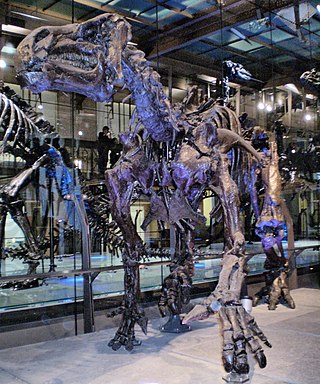
Iguanodon, named in 1825, is a genus of iguanodontian dinosaur. While many species found worldwide have been classified in the genus Iguanodon, dating from the Late Jurassic to Early Cretaceous, taxonomic revision in the early 21st century has defined Iguanodon to be based on one well-substantiated species: I. bernissartensis, which lived during the Barremian to early Aptian ages of the Early Cretaceous in Belgium, Germany, England, and Spain, between about 126 and 122 million years ago. Iguanodon was a large, bulky herbivore, measuring up to 9–11 metres (30–36 ft) in length and 4.5 metric tons in body mass. Distinctive features include large thumb spikes, which were possibly used for defense against predators, combined with long prehensile fifth fingers able to forage for food.
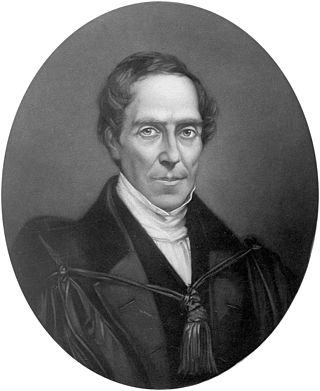
Gideon Algernon Mantell MRCS FRS was an English obstetrician, geologist and palaeontologist. His attempts to reconstruct the structure and life of Iguanodon began the scientific study of dinosaurs: in 1822 he was responsible for the discovery of the first fossil teeth, and later much of the skeleton, of Iguanodon. Mantell's work on the Cretaceous of southern England was also important.

Benjamin Waterhouse Hawkins was an English sculptor and natural history artist renowned for his work on the life-size models of dinosaurs in the Crystal Palace Park in south London. The models, accurately made using the latest scientific knowledge, created a sensation at the time. Hawkins was also a noted lecturer on zoological topics.

Dinosaur is a 2000 American live-action/animated adventure film produced by Walt Disney Feature Animation in association with The Secret Lab, and released by Walt Disney Pictures. The film was directed by Ralph Zondag and Eric Leighton and produced by Pam Marsden, from a screenplay written by John Harrison, Robert Nelson Jacobs, and Walon Green, and a story by the trio alongside Zondag and Thom Enriquez. It features the voices of D. B. Sweeney, Alfre Woodard, Ossie Davis, Max Casella, Hayden Panettiere, Samuel E. Wright, Julianna Margulies, Peter Siragusa, Joan Plowright, and Della Reese. The story follows a young Iguanodon who was adopted and raised by a family of lemurs on a tropical island. They are forced to the mainland by a catastrophic meteor impact; setting out to find a new home, they join a herd of dinosaurs heading for the "Nesting Grounds", but must contend with the group's harsh leader, as well as external dangers such as predatory Carnotaurus.

Hypsilophodon is a neornithischian dinosaur genus from the Early Cretaceous period of England. It has traditionally been considered an early member of the group Ornithopoda, but recent research has put this into question.

The Museum of Natural Sciences of Belgium is a Brussels museum dedicated to natural history. It is a part of the Royal Belgian Institute of Natural Sciences.

Hylaeosaurus is a herbivorous ankylosaurian dinosaur that lived about 136 million years ago, in the late Valanginian stage of the early Cretaceous period of England. It was found in the Grinstead Clay Formation.

Crystal Palace Park is a large park in south-east London, Grade II* listed on the Register of Historic Parks and Gardens. It was laid out in the 1850s as a pleasure ground, centred around the re-location of The Crystal Palace -- the largest glass building of the time -- from central London to this area on the border of Kent and Surrey; the suburb that grew around the park is known by the same name.
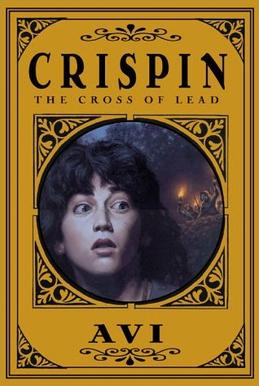
Crispin: The Cross of Lead is a 2002 children's novel written by Avi. It was the winner of the 2003 Newbery Medal. Its sequel, Crispin: At the Edge of the World, was released in 2006. The third and currently final book, Crispin: The End of Time, was released in 2010.

The Paleozoic Museum was a proposed museum of natural history in Manhattan near Central Park. Planning and initial construction for the museum proceeded in 1868–1870; English sculptor Benjamin Waterhouse Hawkins planned and began creation of the dioramas, and the foundations for an eventual structure were laid at Central Park West and 63rd Street. The field of paleontology was in its infancy then, but interest was high for a museum displaying the latest findings. The museum never came to fruition after a combination of political resistance and a bizarre case of vandalism in 1871 that destroyed the dinosaur models that were prepared to be displayed in the museum.
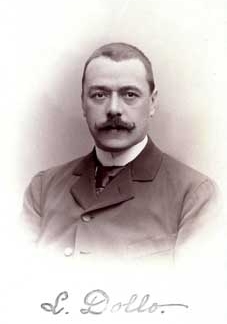
Louis Antoine Marie Joseph Dollo was a Belgian palaeontologist, known for his work on dinosaurs. He also posited that evolution is not reversible, known as Dollo's law. Together with the Austrian Othenio Abel, Dollo established the principles of paleobiology.
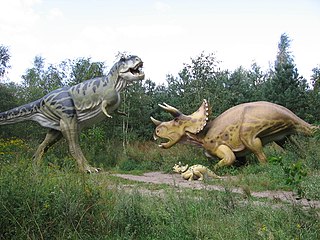
Cultural depictions of dinosaurs have been numerous since the word dinosaur was coined in 1842. The non-avian dinosaurs featured in books, films, television programs, artwork, and other media have been used for both education and entertainment. The depictions range from the realistic, as in the television documentaries from the 1990s into the first decades of the 21st century, to the fantastic, as in the monster movies of the 1950s and 1960s.

Mantellisaurus is a genus of iguanodontian dinosaur that lived in the Barremian and early Aptian ages of the Early Cretaceous Period of Europe. Its remains are known from Belgium (Bernissart), England, Spain and Germany. The type and only species is M. atherfieldensis. Formerly known as Iguanodon atherfieldensis, the new genus Mantellisaurus was erected for the species by Gregory Paul in 2007. According to Paul, Mantellisaurus was more lightly built than Iguanodon and more closely related to Ouranosaurus, making Iguanodon in its traditional sense paraphyletic. It is known from many complete and almost complete skeletons. The genus name honours Gideon Mantell, the discoverer of Iguanodon.
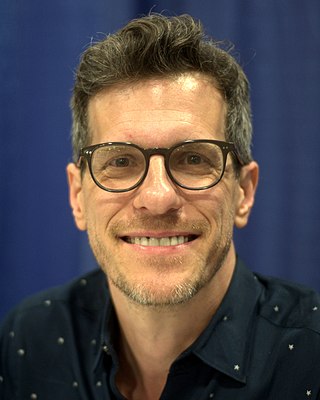
Brian Selznick is an American illustrator and author best known as the writer of The Invention of Hugo Cabret (2007), Wonderstruck (2011), The Marvels (2015) and Kaleidoscope (2021). He won the 2008 Caldecott Medal for U.S. picture book illustration recognizing The Invention of Hugo Cabret. He is also known for illustrating children's books such as the covers of Scholastic's 20th-anniversary editions of the Harry Potter series.

The Crystal Palace Dinosaurs are a series of sculptures of dinosaurs and other extinct animals, inaccurate by modern standards, in the London borough of Bromley's Crystal Palace Park. Commissioned in 1852 to accompany the Crystal Palace after its move from the Great Exhibition in Hyde Park, they were unveiled in 1854 as the first dinosaur sculptures in the world. The models were designed and sculpted by Benjamin Waterhouse Hawkins under the scientific direction of Sir Richard Owen, representing the latest scientific knowledge at the time. The models, also known as the Geological Court or Dinosaur Court, were classed as Grade II listed buildings from 1973, extensively restored in 2002, and upgraded to Grade I listed in 2007.

Mary Ann Mantell was a British fossil collector and the wife of the British paleontologist Gideon Mantell. She is credited – although this is disputed – with the discovery of the first fossils of Iguanodon and provided several pen and ink sketches of the fossils for her husband's scientific description of the Iguanodon.

John Vernon Lord is an illustrator, author and teacher. He is widely recognized for his illustrations of various texts such as Aesop's Fables,The Nonsense Verse of Edward Lear; and the Folio Society's Myths and Legends of the British Isles. He has also illustrated classics of English literature, including the works of Lewis Carroll and James Joyce.

Paleoart is any original artistic work that attempts to depict prehistoric life according to scientific evidence. Works of paleoart may be representations of fossil remains or imagined depictions of the living creatures and their ecosystems. While paleoart is typically defined as being scientifically informed, it is often the basis of depictions of prehistoric animals in popular culture, which in turn influences public perception of and fuels interest in these organisms. The word paleoart is also used in an informal sense as a name for prehistoric art, most often cave paintings.
George Bax Holmes was an English fossil collector. Born into a wealthy Quaker family in Horsham, Sussex, he was the discoverer of the 'Great Horsham Iguanodon'. Having started life pursuing a medical career he was able to devote more time to his fossil hunting from 1834. It was in that year that his father died and left him considerable property interests. As early as 1836 he contributed to Howard Dudley's history of Horsham with a paragraph on his work.

The Dinosaurs of Waterhouse Hawkins is a 2001 picture book by Barbara Kerley and illustrated by Brian Selznick. The book tells the story of Benjamin Waterhouse Hawkins and how he built the Crystal Palace dinosaurs. The book was a recipient of the 2002 Caldecott Honor for its illustrations.



















